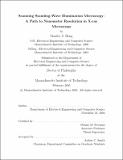| dc.contributor.advisor | Dennis M. Freeman. | en_US |
| dc.contributor.author | Hong, Stanley Seokjong, 1977- | en_US |
| dc.contributor.other | Massachusetts Institute of Technology. Dept. of Electrical Engineering and Computer Science. | en_US |
| dc.date.accessioned | 2005-09-26T15:54:01Z | |
| dc.date.available | 2005-09-26T15:54:01Z | |
| dc.date.copyright | 2005 | en_US |
| dc.date.issued | 2005 | en_US |
| dc.identifier.uri | http://hdl.handle.net/1721.1/27868 | |
| dc.description | Thesis (Ph. D.)--Massachusetts Institute of Technology, Dept. of Electrical Engineering and Computer Science, 2005. | en_US |
| dc.description | This electronic version was submitted by the student author. The certified thesis is available in the Institute Archives and Special Collections. | en_US |
| dc.description | Includes bibliographical references (leaves 79-88). | en_US |
| dc.description.abstract | X-ray microscopy can potentially combine the advantages of light microscopy with resolution approaching that of electron microscopy. In theory, x-ray microscopes can image unsectioned hydrated cells with nanometer resolution. In practice, however, the resolution of x-ray microscopes is limited to approximately 20 nm due to difficulties in the construction of high numerical-aperture (NA) x-ray focusing optics. This thesis represents a step on a new path to nanometer resolution in x-ray microscopy by proposing and demonstrating scanning standing-wave illumination (SWI) microscopy. In scanning SWI microscopy, lensless focusing is achieved with the interference of large numbers of phase-aligned planar wavefronts. Resolution is determined primarily by the NA synthesized by the planar wavefronts, circumventing the need for high-NA optical components. Both theoretical and experimental work conducted at visible wavelengths is presented. An electromagnetic theory of image formation in scanning SWI fluorescence microscopy is developed. The point spread function is remarkably well-suited to Fourier analysis and can be analyzed using graphical techniques. Phase alignment is accomplished by maximizing the intensity of light scattered or fluoresced by a point-like particle using an iterative algorithm that is guaranteed to converge monotonically. A prototype scanning SWI microscope with 15 phase-modulated linearly-polarized laser beams arranged in a 0.95-NA radially-polarized circular cone and a 0.25-NA objective lens is presented. Sub-wavelength resolution according to both classical resolution criteria (i.e., measurement of the point-spread function) and modern resolution criteria (i.e., investigation of limits imposed by noise in computationally restored images) is demonstrated. | en_US |
| dc.description.statementofresponsibility | by Stanley S. Hong. | en_US |
| dc.format.extent | 88 leaves | en_US |
| dc.format.extent | 2148858 bytes | |
| dc.format.extent | 2147772 bytes | |
| dc.format.mimetype | application/pdf | |
| dc.format.mimetype | application/pdf | |
| dc.language.iso | en_US | |
| dc.publisher | Massachusetts Institute of Technology | en_US |
| dc.rights | M.I.T. theses are protected by copyright. They may be viewed from this source for any purpose, but reproduction or distribution in any format is prohibited without written permission. See provided URL for inquiries about permission. | en_US |
| dc.rights.uri | http://dspace.mit.edu/handle/1721.1/7582 | |
| dc.subject | Electrical Engineering and Computer Science. | en_US |
| dc.title | Scanning standing-wave illumination microscopy : a path to nanometer resolution in X-ray microscopy | en_US |
| dc.type | Thesis | en_US |
| dc.description.degree | Ph.D. | en_US |
| dc.contributor.department | Massachusetts Institute of Technology. Department of Electrical Engineering and Computer Science | |
| dc.identifier.oclc | 60663405 | en_US |
